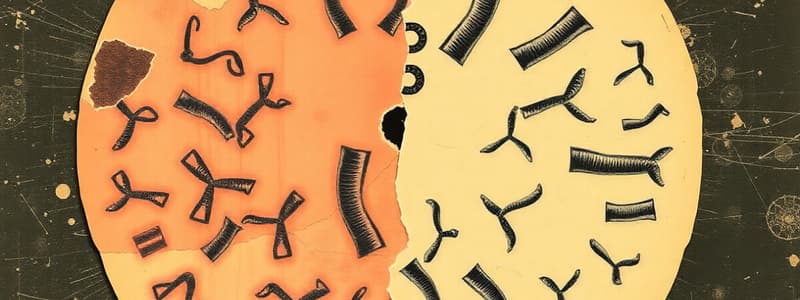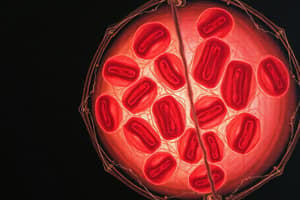Podcast
Questions and Answers
What is the main distinction between mitosis and meiosis?
What is the main distinction between mitosis and meiosis?
- Meiosis involves two rounds of division, while mitosis involves one. (correct)
- Meiosis occurs in somatic cells, while mitosis occurs in gametes.
- Mitosis results in haploid cells, while meiosis results in diploid cells.
- Mitosis includes crossing over, whereas meiosis does not.
What is the purpose of the law of segregation in genetics?
What is the purpose of the law of segregation in genetics?
- To ensure that alleles for a trait are separated during gamete formation. (correct)
- To explain the behavior of linked genes during inheritance.
- To predict phenotypic ratios in polygenic traits.
- To determine the likelihood of two traits being inherited together.
Which phase of the cell cycle is characterized by the replication of DNA?
Which phase of the cell cycle is characterized by the replication of DNA?
- S phase (correct)
- G1 phase
- M phase
- G2 phase
What is the significance of crossing over during meiosis?
What is the significance of crossing over during meiosis?
What type of mutation results in a shift in the reading frame of the genetic code?
What type of mutation results in a shift in the reading frame of the genetic code?
Explain the concept of nondisjunction and its potential effects on an organism.
Explain the concept of nondisjunction and its potential effects on an organism.
How does incomplete dominance differ from codominance? Provide an example of each.
How does incomplete dominance differ from codominance? Provide an example of each.
Describe the significance of crossing over during prophase I of meiosis.
Describe the significance of crossing over during prophase I of meiosis.
What are the primary differences between somatic cells and gametes in terms of ploidy?
What are the primary differences between somatic cells and gametes in terms of ploidy?
Summarize the law of independent assortment and its implications for genetic variation.
Summarize the law of independent assortment and its implications for genetic variation.
What is the role of mRNA in the process of translation?
What is the role of mRNA in the process of translation?
Flashcards are hidden until you start studying
Study Notes
Cell Division
- Cells arise from pre-existing cells
- Cell division allows for growth and repair in multicellular organisms
- Cell division ensures the continuity of life
Chromosomes/Chromatids
- Chromosomes contain DNA, which carries genetic information
- Chromatids are identical copies of a chromosome, joined at the centromere
- During cell division, chromosomes are replicated, creating two sister chromatids
- Humans have 46 chromosomes, organized in 23 pairs
The Cell Cycle
- The cell cycle is a series of events that take place in a cell leading to its division and duplication of its DNA (DNA replication) to produce two daughter cells
- The cell cycle is divided into two main phases:
- Interphase - period of cell growth and DNA replication. This stage is further divided into G1, S, and G2 phases
- Mitotic (M) Phase - period of nuclear division (mitosis) and cytoplasmic division (cytokinesis)
Phases of the Cell Cycle
- G1 Phase: Cell growth and protein synthesis
- S Phase: DNA replication
- G2 Phase: Further growth and preparation for mitosis
- M Phase (Mitosis): Nuclear division
- Cytokinesis: Cytoplasmic division
Mitosis
- Mitosis is the process of nuclear division in eukaryotic cells
- Occurs in somatic cells (non-reproductive cells)
- Produces two genetically identical daughter cells, each with the same number of chromosomes as the parent cell
- Divided into four main phases:
- Prophase: Nuclear envelope breaks down, chromosomes condense, spindle fibers form
- Metaphase: Chromosomes line up at the equator of the cell, attached to spindle fibers
- Anaphase: Sister chromatids separate and move to opposite poles of the cell
- Telophase: Nuclear envelope reforms around the newly formed nuclei, chromosomes decondense
Cytokinesis
- Cytokinesis is the division of the cytoplasm to form two daughter cells
- Occurs concurrently with telophase of mitosis
- In animal cells, a cleavage furrow forms and pinches off the cytoplasm
- In plant cells, a cell plate forms and divides the cytoplasm
Cell Cycle Checkpoints
- Cell cycle checkpoints ensure that the cell cycle progresses correctly
- G1 Checkpoint: Checks for adequate cell size and nutrient availability
- G2 Checkpoint: Checks for DNA replication completion and damage repair
- M Checkpoint: Ensures proper chromosome attachment to spindle fibers
Ploidy
- Ploidy refers to the number of sets of chromosomes in a cell
- Diploid (2n): Cells with two sets of chromosomes (e.g., somatic cells)
- Haploid (n): Cells with one set of chromosomes (e.g., gametes)
Somatic Cells vs Gametes
- Somatic cells are all body cells except for gametes
- Gametes are reproductive cells (sperm and egg)
- Somatic cells undergo mitosis
- Gametes are produced by meiosis
Meiosis
- Meiosis is a type of cell division that produces gametes (sperm and egg)
- Occurs in specialized cells called germ cells
- Produces four daughter cells (gametes), each with half the number of chromosomes as the parent cell
- Divided into two rounds:
- Meiosis I: Separates homologous chromosomes, reduces the chromosome number by half
- Meiosis II: Separates sister chromatids, similar to mitosis
Meiosis I
- Prophase I: Chromosomes condense, homologous chromosomes pair up and exchange genetic material (crossing over), spindle fibers form
- Metaphase I: Homologous chromosome pairs line up at the equator of the cell, attached to spindle fibers
- Anaphase I: Homologous chromosomes separate and move to opposite poles of the cell
- Telophase I: Nuclear envelope reforms around the newly formed nuclei, chromosomes decondense
Meiosis II
- Similar to mitosis, but each cell only has one set of chromosomes
- Prophase II: Chromosomes condense, spindle fibers form
- Metaphase II: Chromosomes line up at the equator of the cell, attached to spindle fibers
- Anaphase II: Sister chromatids separate and move to opposite poles of the cell
- Telophase II: Nuclear envelope reforms around the newly formed nuclei, chromosomes decondense
Mitosis vs Meiosis
- Mitosis: Produces two genetically identical daughter cells, occurs in somatic cells
- Meiosis: Produces four genetically diverse daughter cells (gametes), occurs in germ cells
Crossing Over
- Crossing over is the exchange of genetic material between homologous chromosomes during prophase I of meiosis
- Results in genetic recombination, increasing genetic diversity
Homologous Chromosomes
- Homologous chromosomes are pairs of chromosomes, one from each parent
- They have the same genes but may have different alleles (variations of a gene)
Nondisjunction
- Nondisjunction is the failure of chromosomes to separate properly during cell division
- Can result in aneuploidy, where cells have an abnormal number of chromosomes
- Examples of aneuploidy: Down syndrome (trisomy 21), Turner syndrome (XO), Klinefelter syndrome (XXY)
Alleles
- Alleles are alternative forms of a gene
- Heterozygous: An individual with two different alleles for a trait (e.g., Aa)
- Homozygous: An individual with two identical alleles for a trait (e.g., AA or aa)
- Dominant: An allele that masks the expression of the recessive allele (e.g., A is dominant to a)
- Recessive: An allele that is only expressed when two copies are present (e.g., a is recessive to A)
Mendel's Laws
- Law of Segregation: Each individual inherits one allele for each trait from each parent.
- Law of Independent Assortment: Alleles for different traits separate independently of each other during gamete formation.
Crosses
- Punnett squares are diagrams used to predict the possible genotypes and phenotypes of offspring from a cross
- P generation: Parental generation
- F1 generation: First filial generation (offspring of the parental generation)
- F2 generation: Second filial generation (offspring of the F1 generation)
- Incomplete dominance: The phenotype of the heterozygote is intermediate between the phenotypes of the two homozygotes (e.g., red flower x white flower = pink flower)
- Codominance: Both alleles are expressed in the heterozygote (e.g., black chicken x white chicken = black and white speckled chicken)
- Polygenic Inheritance: Many genes contribute to a single trait (e.g., height, skin color)
- Linked genes: Genes that are located close together on the same chromosome and tend to be inherited together
DNA Structure
- DNA is a double helix structure made up of nucleotides
- Each nucleotide consists of a sugar (deoxyribose), a phosphate group, and a nitrogenous base
- The four nitrogenous bases in DNA are: Adenine (A), Guanine (G), Cytosine (C), and Thymine (T)
- A pairs with T, and G pairs with C, held together by hydrogen bonds
DNA Replication
- DNA replication is the process by which DNA is copied
- Occurs during the S phase of interphase
- The process is semiconservative, meaning each new DNA molecule contains one original strand and one newly synthesized strand
- DNA polymerase is the enzyme that adds nucleotides to the new strand, following the base pairing rules (A with T, G with C)
Transcription
- Transcription is the process of copying DNA into RNA
- Occurs in the nucleus
- RNA polymerase is the enzyme that transcribes DNA into mRNA
- mRNA (messenger RNA) carries the genetic code from DNA to ribosomes
Translation
- Translation is the process of converting mRNA into protein
- Occurs in the cytoplasm, at ribosomes
- Ribosomes are made up of rRNA (ribosomal RNA) and proteins
- tRNA (transfer RNA) molecules carry specific amino acids to the ribosomes
- The genetic code is read in triplets called codons, each codon specifying a particular amino acid
- The sequence of codons in mRNA determines the sequence of amino acids in the protein
Mutations
- Mutations are changes in the DNA sequence
- Can be spontaneous or caused by mutagens
- Types of mutations:
- Substitutions: One base is replaced with another
- Insertions: One or more bases are added to the DNA sequence
- Deletions: One or more bases are removed from the DNA sequence
- Frame-shift mutations: Insertions and deletions can cause a shift in the reading frame of the genetic code, altering the amino acid sequence of the protein
Cell Division
- Cells arise from pre-existing cells, through cell division.
Chromosomes/Chromatids
- Chromosomes are made of DNA and are located in the nucleus of a cell.
- Chromatids are duplicated identical halves of a chromosome.
- Sister chromatids are attached by the centromere.
Cell Cycle
- The cell cycle is a series of events a cell undergoes to divide and reproduce.
- The cell cycle includes two phases: Interphase and M Phase.
- Interphase has three stages:
- G1 - Cell grows and functions normally.
- S - DNA is replicated to produce sister chromatids.
- G2 - Cell continues to grow and prepares for division.
- M Phase has two stages:
- Mitosis - Division of the nucleus.
- Cytokinesis - Division of the cytoplasm.
- Interphase has three stages:
- Mitosis has four stages:
- Prophase - Chromosomes condense and become visible, the nuclear envelope breaks down, and spindles form.
- Metaphase - Chromosomes line up at the center of the cell (metaphase plate), attached to the spindle fibers.
- Anaphase - Sister chromatids separate and move to opposite poles of the cell.
- Telophase - Chromosomes decondense, nuclear envelope reforms, and the cytoplasm divides.
- Cytokinesis occurs after mitosis and involves the division of the cytoplasm, resulting in two separate daughter cells.
- Cell cycle checkpoints:
- These control the progression of the cell cycle, ensuring proper replication and division.
- G1 Checkpoint - Checks for proper cell size and growth factors, ensuring proper conditions for division.
- G2 Checkpoint - Checks for complete DNA replication and damage, preventing errors in division.
- M Checkpoint - Checks for proper chromosome attachment to spindle fibers, preventing errors with chromosome segregation.
Ploidy/Diploid vs Haploid
- Ploidy refers to the number of sets of chromosomes in a cell.
- Diploid cells have two sets of chromosomes (2n), one from each parent.
- Haploid cells have one set of chromosomes (n).
- Somatic cells are body cells and are diploid.
- Gametes are sex cells (sperm and egg) and are haploid.
Meiosis
- Meiosis is a specialized type of cell division that produces gametes (sperm and egg cells).
- Meiosis involves two rounds of division: Meiosis I and Meiosis II.
- Meiosis I reduces the chromosome number by half.
- Prophase I - Homologous chromosomes pair up and exchange genetic material (crossing over).
- Metaphase I - Homologous chromosome pairs line up at the center of the cell.
- Anaphase I - Homologous chromosomes separate and move to opposite poles.
- Telophase I - The cytoplasm divides, forming two haploid cells.
- Meiosis II further divides the chromosomes, resulting in four haploid daughter cells.
- Prophase II - Chromosomes condense.
- Metaphase II - Chromosomes line up at the center of the cell.
- Anaphase II - Sister chromatids separate, moved to opposing poles..
- Telophase II - The cytoplasm divides, resulting in four haploid gamete cells.
Mitosis vs Meiosis
- Mitosis produces two identical diploid daughter cells from one diploid parent cell.
- Meiosis produces four genetically diverse haploid daughter cells from one diploid parent cell.
Crossing Over
- Crossing over is the exchange of genetic material between homologous chromosomes during Prophase I of Meiosis I.
- This process leads to genetic variation.
Homologous Chromosomes
- Homologous chromosomes are pairs of chromosomes that have the same genes, but may carry different alleles for those genes.
- One chromosome of each pair comes from the mother, and the other from the father.
Nondisjunction
- Nondisjunction is the failure of chromosomes to separate properly during cell division.
- This can occur during Meiosis I or Meiosis II.
- It can result in gametes with extra or missing chromosomes, leading to genetic disorders such as Down syndrome.
Alleles
- Alleles are alternative forms of a gene.
- Heterozygous - Having two different alleles for a trait.
- Homozygous - Having two identical alleles for a trait.
- Dominant - An allele that masks the expression of the recessive allele.
- Recessive - An allele that is only expressed when two copies are present.
Mendel's “laws”
- Law of Segregation - For every trait, only one allele from each parent is passed on to the offspring.
- Law of Independent Assortment - The inheritance of one trait is independent of the inheritance of another trait.
Crosses
- Punnett squares are a visual representation of possible genotypes and phenotypes of offspring from a cross.
- P generation - Parental generation.
- F1 generation - First filial generation (offspring of the P generation).
- F2 generation - Second filial generation (offspring of the F1 generation).
- Incomplete Dominance - A blending of the phenotypes of the two alleles in a heterozygote.
- Codominance - Both alleles are expressed in a heterozygote.
- Polygenic Inheritance - A trait is controlled by multiple genes.
- Linked Genes - Genes that are located close together on the same chromosome and tend to be inherited together.
DNA Structure
- DNA is a double helix, with two strands running in opposite directions.
- Strands are linked by complementary base pairs:
- Adenine (A) pairs with Thymine (T).
- Guanine (G) pairs with Cytosine (C).
DNA Replication
- Semiconservative replication - Each new DNA molecule consists of one original strand and one newly synthesized strand.
- DNA replication occurs in the S phase of interphase.
Transcription
- Transcription is the process of copying DNA into RNA.
- mRNA (messenger RNA) is a type of RNA that carries the genetic information from DNA to the ribosomes for protein synthesis.
Translation
- Translation is the process of converting mRNA into protein.
- Ribosomes are the sites of protein synthesis.
- rRNA (ribosomal RNA) is a component of ribosomes.
- tRNA (transfer RNA) carries amino acids to the ribosomes and matches them to the codons on mRNA.
- Triplet code/codons - Each set of three bases (codon) on mRNA codes for a specific amino acid.
Mutations
- Mutations are changes in the DNA sequence.
- Substitution - One base is replaced by another.
- Insertion - A base is added.
- Deletion - A base is removed.
- Frameshift - Insertion or deletion that shifts the reading frame of codons.
Studying That Suits You
Use AI to generate personalized quizzes and flashcards to suit your learning preferences.




